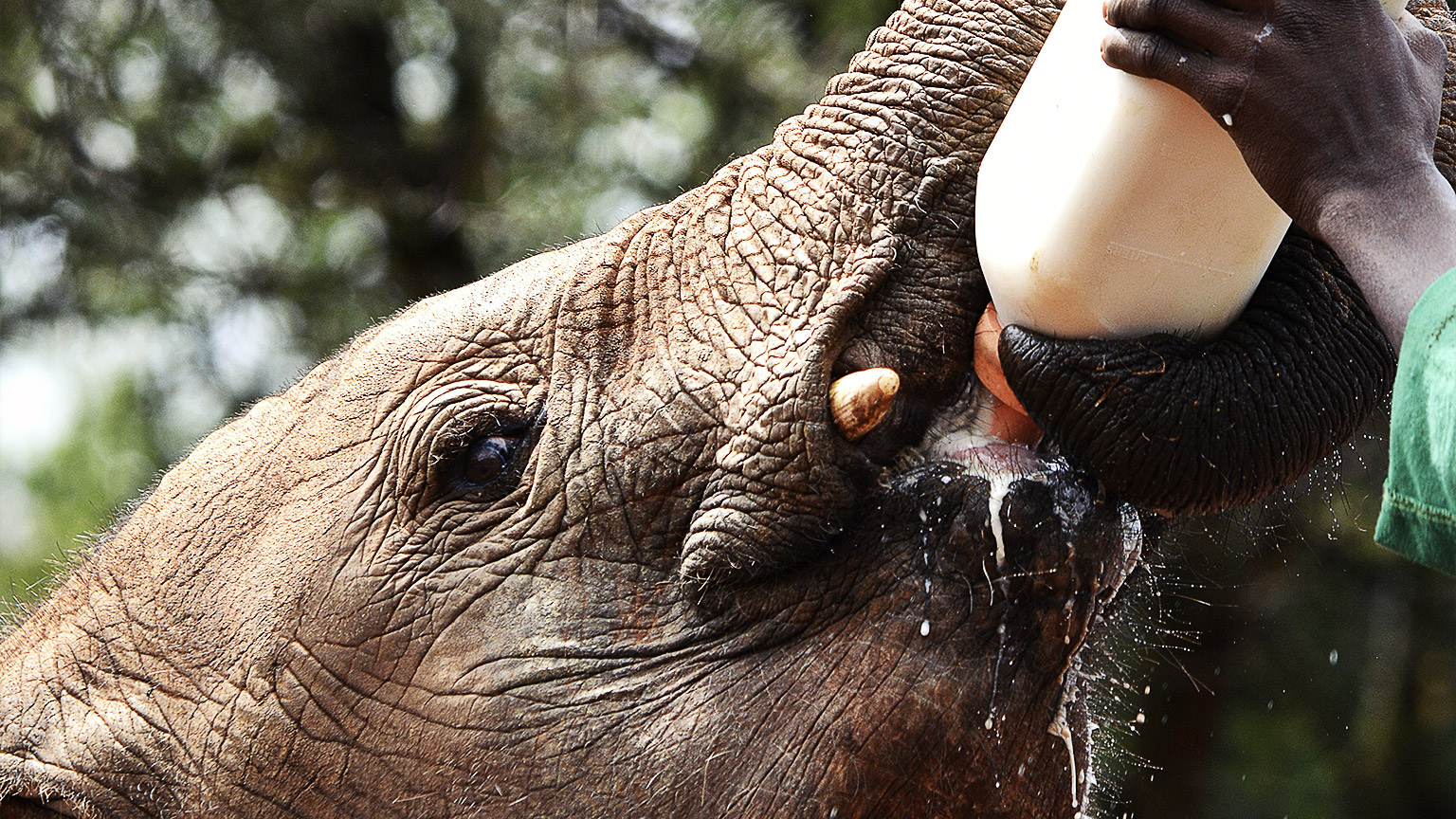Creating effective feeding plans and preparing for feeding and watering are crucial responsibilities in animal care. They ensure that each animal's nutritional and hydration needs are met, promoting good health and preventing issues like malnutrition, obesity, or dehydration.
Before we explore this throughout the module, let us go through a quick overview of feeding and watering animals.
Feeding Plans
A feeding plan is a structured approach to providing the appropriate quantity and type of food at the correct times for each animal. Key considerations when designing feeding plans include:
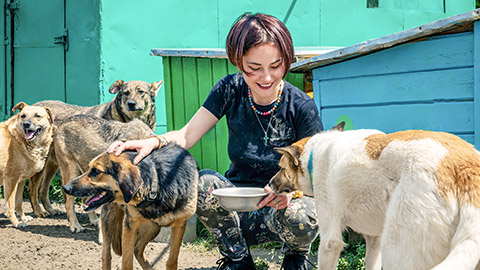
Species-Specific Diets:
- Different species have distinct dietary needs. For example:
- Carnivores (e.g., dogs, cats, snakes) require meat-based diets.
- Herbivores (e.g., rabbits, guinea pigs) need plant-based diets like hay and fresh vegetables.
- Omnivores (e.g., birds and some reptiles) need a combination of plant and animal-based foods.
Life Stage and Health Conditions:
- Age, size, and health conditions impact feeding needs. Puppies, kittens, and juvenile animals often require more frequent feeding with nutrient-dense food to support growth, while senior animals may need specific diets to manage health conditions like arthritis or kidney disease.
Portion Control and Feeding Frequency:
- It is essential to give animals the correct amount of food to prevent overfeeding or underfeeding. Larger animals may need larger portions, while smaller animals or those with special dietary needs require more frequent, smaller meals.
- Feeding schedules should be developed based on the animal's activity level, metabolism, and individual needs.
Monitoring and Adjusting Feeding Plans:
-
Feeding plans are not static and should be monitored and adjusted regularly based on changes in the animal’s weight, health, or activity level. Tracking food intake and observing body condition are important for making adjustments.
Best Practices
- Tailor feeding schedules to individual animals and their specific needs.
- Regularly monitor water and food intake to ensure proper hydration and nutrition.
- Adjust feeding plans based on changes in health, age, or activity level.
- Ensure hygiene and safety in food preparation, handling, and storage.
Preparing for Feeding and Watering
Once a feeding plan is established, preparing the food and water involves several critical steps to ensure hygiene, safety, and proper nourishment.
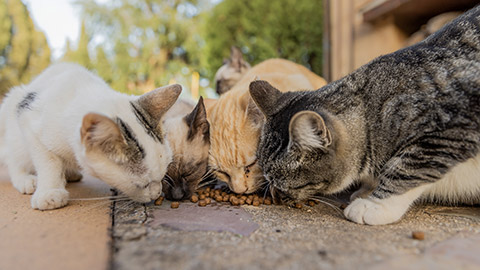
Food Storage:
- Proper storage is crucial to maintaining the quality of food and preventing spoilage or contamination.
- Dry food (e.g., kibble, grains) should be stored in airtight containers to prevent pests and moisture.
- Wet food (e.g., canned food, fresh meat) must be refrigerated once opened and consumed within a short period.
- Frozen food (e.g., prey for reptiles) should be thawed appropriately, avoiding direct sunlight or unsanitary conditions.
Portioning and Preparing Food:
- Each animal's food should be portioned according to its feeding plan. Proper tools (e.g., scoops and measuring cups) should be used to ensure accurate portions.
- For certain animals, preparation may involve cutting or mixing food or defrosting frozen items like raw meat or prey for carnivorous species.
Providing Fresh Water:
- Animals need constant access to clean, fresh water. Water bowls, bottles, or other delivery systems should be checked daily to ensure they are clean and full.
- For certain species (e.g., reptiles), specific hydration methods like misting or soaking may be necessary.
Maintaining Hygiene:
- Feeding areas, bowls, and tools should be cleaned after each use to prevent the spread of bacteria and other contaminants.
- Gloves and protective equipment may be needed, especially when handling raw meat or feeding reptiles with live or frozen prey.
Observation and Record Keeping:
- Careful observation of feeding behaviour (e.g., appetite, food preferences) helps identify changes in the animal's health or dietary needs.
- Record keeping is essential for tracking feeding patterns, monitoring water consumption, and managing food inventory.
Watch
The next video is by Taylor Dean going through the routine at home to feed all of her pets.
The next video is from Big Cat Rescue, which explains their feeding schedule for the animals.
The next video explains how they feed animals at a shelter.

Before you learn how to feed and water animals, it is important to understand the basic principles of animal welfare and ethics.
Animal Ethics
Ethical management and handling of animals are critical to the animal care industry. As an animal carer, it is your responsibility to behave ethically when working with animals. You can think about ethical behaviours as ‘doing the right thing’ or ‘doing what is best’ for the animal.
You can be confident that you are upholding animal ethics if you follow the principles of animal welfare.
Principles of Animal Welfare
There are eight key principles of animal welfare.
- Animals should not suffer from prolonged hunger
- Animals should not suffer from prolonged thirst
- Animals should have a comfortable environment
- Animals should have enough space to be able to move around freely
- Animals should be free of physical injuries
- Animals should be free of disease
- Animals should not suffer pain, fear or stress
- Animals should be able to express normal, non-harmful social behaviours.
The following table summarises the principles and how you can uphold them as an animal carer in the workplace.
| Principle | The animal should have access to: | As an animal carer, you should: |
|---|---|---|
| Animals should not suffer from prolonged hunger |
|
|
| Animals should not suffer from prolonged thirst |
|
|
| Animals should have a comfortable environment |
|
|
| Animals should have enough space to be able to move around freely |
|
|
| Animals should be free of physical injuries |
|
|
| Animals should be free of disease |
|
|
| Animals should not suffer pain, fear or stress |
|
|
| Animals should be able to express normal, non-harmful social behaviours |
|
|
In this course, your focus is on providing the animal with appropriate food and water and conducting safe and humane handling.
The Animal Welfare Charter (pdf) from Taronga Conservation Society Australia, based in Sydney, is an excellent example of how animal ethics and welfare principles are upheld in a large animal care organisation.
Feeding and Watering Animals in an Ethical Manner
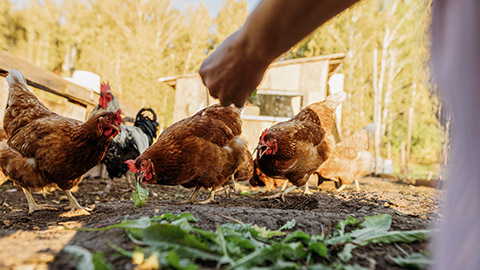
Upholding animal welfare and ethics often requires some compromise. For example, many snakes eat mice and rats in the wild. If you follow the principle that animals should be able to express normal behaviours, you might consider feeding a captive snake a live mouse. However, you must also consider the welfare of the mouse! In an enclosure, the mouse has no means of escape from its predator, which is highly stressful for the mouse. The snake may not make a clean kill, meaning the mouse may suffer unnecessary pain and distress. In its attempt to escape, the mouse will likely bite the snake in defence. Depending on the severity of the bites, the snake could be injured or become ill if the bites become infected. In short, feeding live mice to snakes fails to meet more welfare principles than it meets and so is considered unethical. “The feeding of live mammals to snakes is strongly opposed” by the Australian Veterinary Association (AVA) (2008) and many other organisations in the animal care industry.
Pet food regulations
In Australia, pet food safety is regulated by the Pet Food Industry Association of Australia (PFIAA). The Australian Standard for the Manufacturing and Marketing of Pet Food (AS 5812–2017) is a set of guidelines that manage the production of pet food to ensure that:
- pet food is labelled appropriately
- nutrients, especially vitamins and minerals, are included and appropriate for the intended animal
- any preservatives used are safe for animal consumption (RSPCA 2019).
Safe and Humane Animal Handling Techniques and Procedures
You must have a good understanding of your facility's safe and humane animal handling techniques and procedures. Follow the specific techniques and procedures relevant to the species you are handling at all times. When handling an animal, you must always do so in a manner that is safe for you and the animal. It is also important to remember that:
- owners of the animals will watch you to learn how to handle their animal properly;
- handling animals correctly will prevent other staff from being injured and
- handling animals appropriately will help reduce stress for the animal.
Watch
The next video is an explanation of FDA guidelines on Pet Food.
Preparing to Handle an Animal
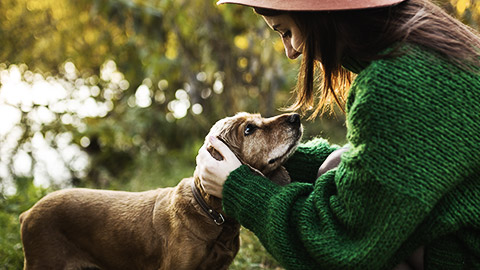
Give the animal you will handle your total concentration before and during handling. Safe handling requires you to have good knowledge and the ability to read the body language of the animal that you are handling. Don’t rush straight in and put your hands on the animal. Instead, take a few moments to visually assess the animal that you are about to handle. Ask yourself some questions to evaluate the animal and the situation. Of course, you may ask hundreds of other questions, depending on how the animal arrived and with whom. However, the following are just a few questions you might use to assess the situation and identify the safe handling techniques that may be appropriate.
- Is the animal wild or someone’s pet? Wild animals are unlikely to have had much contact with people and may be very difficult to handle.
- Do you have a history of this animal? Can you ask the owner about the animal’s behaviour?
- Is the animal well socialised?
- Is the animal injured or unwell?
- Is the animal stressed? Many animals will be stressed simply being in the unfamiliar environment of an animal care facility.
Taking a few moments to assess and interpret the animal’s behaviour will make it easier for you to handle it and safer for both of you. The techniques you choose to handle the animal will vary depending on the situation.
Handling Sick or Injured Animals
Animals tend to be less accepting of handling when sick or injured. So, it is vital to be able to recognise when an animal is sick or injured. Some common signs of illness and injury in animals may include:
- laboured breathing
- the presence of blood
- the presence of mucous
- open wounds
- limbs at odd angles
- limping
- whimpering
- lethargy
- not eating.
It is important to remember that even the calmest animal in the world can bite in response to pain. Your handling technique may vary depending on the type of illness or injury. No matter what, following the health and safety guidelines and your facility’s policies on handling animals is essential. If you have any doubts about the temperament or health of an animal, ask another staff member for assistance. There is no reason to take shortcuts. The safety of all concerned is paramount. For more information about behavioural indicators of stress and pain in cats and dogs, read the information sheet, Behavioural Red Flags, by the University of Wisconsin-Madison School of Veterinary Medicine.
Safe Animal Handling Techniques
The following are a few examples of safe and humane animal handling techniques.
- Concentrate on the animal you are handling without being distracted by other activities.
- Do not put your face directly into the face of an animal. The animal may find it threatening, and you might get scratched or bitten.
- Do not move in behind or crowd around an animal.
- Avoid direct eye contact but maintain safe visual contact with the animal.
- Talk in soothing tones. Avoid high-pitched, excited talking.
- Never sit on the floor while handling an animal. There may be a chance that the animal might become aggressive or aroused, making it hard for you to get up, move out of the way or protect yourself from kicks, scratches or bites (Rural Area Vet, n.d.).
Safe and humane animal handling requires a thorough understanding of each species' typical behaviour and responses, as well as using the correct techniques. There is no substitute, however, for careful observation and experience.
Watch
The following video (6:53 min) demonstrates how to approach and pick up a cat safely. Different animals require different techniques.
The next video is demonstrating how to restrain the mouse.
The next video explains how to work/ handle larger animals you may come into contact with, like cattle and horses.
The next video explains safe handling with a dog.
The next video features the importance of safety gloves and handling different types of animals, especially dangerous animals like snakes and crocodiles etc.
Knowledge Check 1
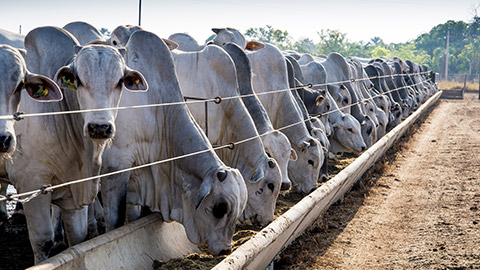
All animals need to eat food to survive. The type of food they require depends on the species of animal as well as its life stage and other individual requirements. Different animals must be fed at different frequencies depending on their specific nutritional requirements. For example, a 3-week-old kitten may need to be fed every 4 to 6 hours, while an adult python may only need to eat once every 10 days or so. So, before you feed an animal in an animal care facility, you must confirm whether it is feeding time for them. This information is part of the animal’s feeding plan. You can also locate this information by:
- checking with your supervisor
- reading the:
- cage card
- hospital charts
- treatment board.
- completing the rounds of the cages
- getting a verbal handover from the previous shift.
Feeding Plans
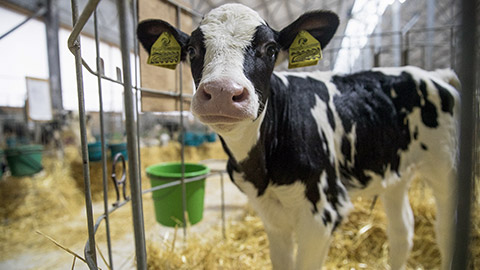
A feeding plan provides instructions about what the animal should be fed and how often. The cage card attached to the animal’s cage or enclosure typically outlines the critical aspects of the feeding plan. A more detailed feeding plan will be kept in the animal’s file. You will need to familiarise yourself with the location of feeding plans in your organisation. Feeding plans may include instructions about the following:
- types of food to feed the animal
- any required medications or supplements
- feeding frequency, rates and times
- feeding methods and procedures such as:
- hand feeding
- bottle feeding
- free feeding
- controlled feeding.
- how to introduce dietary changes to the animal
- nutrient requirements for the animal according to its life stage and condition
- how to present food to stimulate activity and allow the animal to mimic normal wild behaviour
- supervisor instructions, such as:
- liquid diets
- restricted diets.
- target weights
- reporting and recording requirements
- weed and pest control strategies (when feeding animals food containing seeds).
A targeted feeding plan will support the treatment of many medical conditions, such as diabetes, obesity and pregnancy.
Scenario: Watermelon
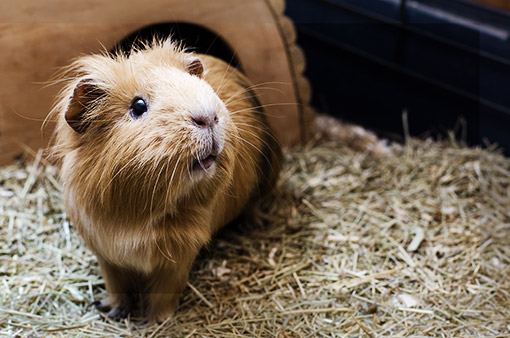
Watermelon is a guinea pig in your care. The following table is a typical example of the information included on a cage card that would be located on her cage in the boarding facility.
| ABC All Animal Boarding | |||||||
|---|---|---|---|---|---|---|---|
| Animal name: Watermelon
|
Owner name: Truss Owner number: 0400 800 800 |
Species: Cavy (guinea pig) Breed: Satin Age: 1 year Colour: Golden |
Sex: Female Desexed: No Weight: 470 g |
||||
| Stay | Feeding | Services | |||||
|
Date in: 18/07/2022 Date out: 01/08/2022 |
Product: Fresh vegetables (named container in the fridge) Amount: 1/2 cup per meal Frequency/timing: Morning and evening |
Hydrobath - flea/tick: No Hydrobath - medicated: No Hand bath: No |
Clip (details): No Nail clip: Yes |
||||
| Vaccinations | Preventative health | Medication / supplements | |||||
|
Due date: n/a Type: |
Product: Due date: |
Product: Vitamin C powder Dose: 1/2 scoop daily Timing: Evening, on food |
|||||
| Notes: | |||||||
| Date | Eat | Drink | Urine | Faeces | Medication | Notes: | |
Case Study
Animal Feeding Plan Template
Animal Information
| Animal Type | |
| Breed | |
| Age | |
| Weight | |
| Purpose |
Daily Feed Breakdown
| 1: Morning Feeding | |
|
|
|
|
|
|
| 2: Afternoon Feeding | |
|
|
|
|
|
|
| 3: Evening Feeding | |
|
|
|
|
|
Weekly/ Occasional Feeding Adjustments
| Frequency of Feeding | |
| Special Needs | |
| Adjustments for Breeding/ Health |
Feeding Notes
| Observation Notes | |
| Handling |
Case Study
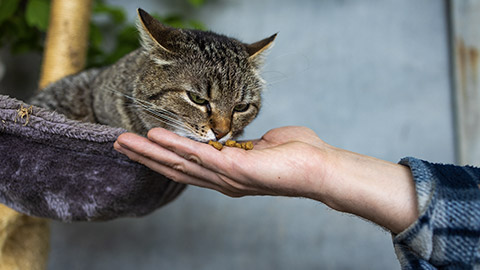
Identifying Animals that Require Feeding at the Start of a Shift
At Happy Paws Animal Care, Maya begins her shift by checking the daily care schedule, which lists the feeding times for each type of animal. As part of her morning routine, Maya must determine which animals require immediate feeding to ensure they receive the right nutrients at the appropriate times.
Upon entering the facility, Maya first checks the enclosures of the reptiles—including snakes, lizards, and turtles. She knows that reptiles often follow strict feeding schedules, and most of them need to be fed less frequently than mammals. According to the schedule, the snakes only require feeding every few days, so today is not one of their feeding days. However, the turtles and lizards need to be fed today, so Maya prepares their specialized diets, which include fresh greens, fruits, and live insects.
Next, Maya moves on to the dogs and cats housed at the facility. These animals are typically fed twice daily—once in the morning and once in the evening. Maya checks the chart and sees that several dogs have specific dietary requirements due to age or medical conditions, so she prepares their individual meals accordingly, ensuring that portion sizes and ingredients match their needs. The cats, who are fed wet food in the mornings, also have their meals ready, with some cats requiring specialized food for digestion or urinary health.
Lastly, Maya checks the goats and alpacas in the outdoor enclosure. These animals are grazers, and while they have access to grass throughout the day, they also receive supplemental feed in the morning. Maya ensures their grain and hay are topped up, paying special attention to the quantity based on the number of animals in the enclosure.
Maya completes the task of identifying the animals that require feeding and preparing their meals, ensuring that each animal’s specific needs are met to maintain their health and well-being.
Key Points in Identifying Animals that Require Feeding:
- Reptiles: Reptiles like turtles, lizards, and snakes often have varying feeding schedules, with some needing to be fed daily while others require food every few days or weeks. Their dietary needs must be checked against their specific schedules.
- Dogs and Cats: Typically require feeding twice daily (morning and evening). Special diets may be necessary for animals with medical or age-related conditions, requiring staff to check for specific food types or portion sizes.
- Grazing Animals (Goats and Alpacas): While these animals have access to grass, supplemental feed is often provided once or twice daily to ensure proper nutrition.
By checking the schedule and understanding the feeding requirements of each species, Maya ensures that the animals are well-fed and healthy throughout the day.
How can you identify/ check the feeding requirements of Animals
- Check with your supervisor
- Read the cage cards
- Read the hospital charts
- Read the treatment board
- Complete rounds
- Get a verbal handover from the previous shift
Identify Food and Food Supplements and Prepare in line with Feeding Plans
While the feeding plan provides feeding instructions, it is helpful to understand the nutritional needs of animals and how they can change during their life as they age or become ill.
Basic Nutritional Requirements
Different species of animals have different basic nutritional needs. Even within a species, such as cats and dogs, different breeds have different dietary requirements. Nutritional needs will also vary depending on the individual’s age, weight, gender, lifestyle, genetic makeup and general health.
Seven types of nutrients
While specific nutritional requirements vary, seven types of nutrients are essential for all animal health, growth and development. Select each of the following nutrient types to learn more.
Carbohydrates are the primary source of energy for movement and growth for most animals. Animals typically get their carbohydrate needs from grains (Ron Fields Nutrition n.d.).
Proteins are vital for the growth and development of the animal. Proteins are present in all animal tissue types, such as skin, muscle and organs. Proteins also form enzymes and some hormones, which keep bodily functions happening (Ron Fields Nutrition n.d.).
While meats are very high in protein, many animals get their protein needs from plant-based foods such as nuts, seeds and grains.
Fats are used to produce cell membranes and some types of hormones. Fats are also used to store energy and help the body absorb other nutrients, such as fat-soluble vitamins. Fats can also help give an animal a glossy coat, especially in horses, and improve milk production, such as in dairy cows (Ron Fields Nutrition n.d.). Foods such as fish oils and vegetable oils are common sources of fats in animal diets.
Fibre is critical for healthy digestion. It can help the animal absorb water and other nutrients, as well as promote the growth of good gut bacteria. The structural components of most plants, such as grasses, stems and leaves, are made of fibre. So, most herbivores get plenty of fibre in their diets. However, it has been shown that even carnivores, such as cats and dogs, benefit from fibre in their diet (Williams 2011).
Vitamins are organic compounds that are vital for a range of different bodily functions. For example, vitamin A is essential for good vision, general growth, foetal development and immune function, while vitamin K is critical for blood clotting in dogs (Burke 2020). Different vitamins are present in various foods, which is why a varied diet can be important for many animals. Vitamins can also be given to animals in the form of supplements.
Minerals are inorganic substances that are critical for normal bodily functions in animals. Seven of the most common minerals required in animal diets are:
- phosphorus
- calcium
- chloride
- magnesium
- potassium
- sulphur
- sodium (Hill's Pet Nutrition 2018).
Water is essential for the health of all animals. Water is vital to keep the animal hydrated, allowing it to regulate its temperature and prevent overheating. Water is needed for “regulating pH, assisting with digestion, joint lubrication and energy production” (Ron Fields Nutrition n.d.). All animals need a constant supply of clean drinking water.
A balanced diet will consist of all seven nutrient types in varying amounts, depending on the general diet type and species.
General diet types
All animals can be broadly classified into three groups based on the type of food they eat.
- Carnivores – animals that eat meat and other animal products
- Herbivores – animals that eat plant products
- Omnivores – animals that eat a combination of animal and plant products.
Watch
The following video (3:18 min) gives a brief overview of the differences between carnivores, herbivores and omnivores.
Within these three groups, there are more specialised diet types. Polyphagy is the ability of an animal to eat a variety of food. This may mean the ability to eat both plant and animal products, such as in humans or dogs, or it may mean the animal can eat a wide range of the same general food type, such as cats being able to eat birds, mammals and reptiles.
In rare cases, some diets are so specialised that the animal can only eat one type of food, and other foods will make them ill. This type of diet is called monophagy. For example, Koalas can only eat eucalyptus leaves. Other types of plant materials disrupt their digestive system and make them sick.
The following table provides just a few examples of the more specific diet types within each of the three main categories.
| Carnivore subcategories | Herbivore subcategories | Omnivore subcategories |
|---|---|---|
|
|
|
general nutritional requirements
Good quality and balanced dry food that lists protein as its first ingredient is important for cat and dog nutrition. This is especially true for cats because they are obligate carnivores – animals whose diets are at least 70% meat and can’t digest plant materials properly (Australian Museum 2018). Dry food has the added benefit of helping prevent dental disease as the animal chews.
Many high-quality commercial wet foods also provide a balanced diet. Animals can also be fed semi-moist or raw food diets. For example, herbivores, such as rabbits and guinea pigs, need a balance of good-quality pellets, hay, fresh fruit, and vegetables.
There are benefits to all types of diets. The critical thing to remember is that whatever the kind of diet, it must meet the animal's nutritional needs.
Fresh, clean, cold water must be available at all times for all species of animals unless there is a specific reason, such as a surgical procedure scheduled in the next 6-12 hours.
Exceptions to a typical diet, such as restricted water, will be noted on the feeding plan and should be followed at all times.
Nutrition & Feeding (pdf) provides more information about giving a balanced diet to captive animals and describes feeding practices to promote animal welfare.
Specific animal nutritional needs
As mentioned previously, different animal species have different nutritional requirements. In this course, we will focus on the specific needs of the following four species:
- Cats
- Dog
- Guinea pigs
- Horses.
Cats are carnivores, which means they get all their nutrition from eating other animals. Guinea pigs and horses are herbivores, so they must meet their nutritional needs by eating plant-based foods. Dogs are omnivorous and so get their nutrients from a range of both plant and animal products.
The following table summarises the key nutritional requirements of a balanced diet for the four different animal species (Sanderson 2016, Red Barn 2018).
| Nutrients | Cats | Dogs | Guinea pigs | Horses |
|---|---|---|---|---|
| Carbohydrates | There is no minimum dietary requirement for carbohydrates in cats. Domestic cats are true carnivores and do not need dietary carbohydrates because they use glucogenic amino acids and glycerol to synthesise glucose. Cats tolerate well-cooked, nonfibrous carbohydrates. However, uncooked carbohydrates are poorly digested. | There is no minimum dietary requirement for carbohydrates in domestic dogs. However, carbohydrates are essential for tissue health, such as the brain and red blood cells. | The diet should be low in carbohydrates and sugars but high in fibre. | Carbohydrates, in the form of fermentable fibre or starch, are the primary source of energy for horses. |
| Proteins | Animal proteins are the main component of the diet. For adult maintenance, cat food should have a minimum of 26% protein. During growth and reproduction, a minimum of 30% should be provided. Cars require the following essential amino acids in their diet:
|
Animal or plant-based proteins should be the first listed ingredient. For adult maintenance, dog food should have a minimum of 18% protein. During growth and reproduction, a minimum of 22% should be provided. | Low amount needed. The protein content of the diet must be lower than the fibre content of the diet. A good protein level is around 15-16% crude protein. | Most adult horses require 8 to 10% of their diet to be protein. However, lactating mares and young-growing foals require a higher percentage. |
| Fats |
Moderate amount needed from meat. For adult maintenance as well as growth and reproduction, cat food should have a minimum of 9% fat and must include the following fatty acids:
|
For adult maintenance, dog food should have a minimum of 5% fat. During growth and reproduction, a minimum of 8% should be provided. | Low in fat, less than 2%. | Fat is low in the diet, with around 2 to 6% found in most premixed feeds; however, some higher fat feeds will contain 10 to 12% fat. |
| Fibre | Small amounts are needed for healthy digestion. | Small amounts are needed for healthy digestion. | The bacteria contained in the caecum are kept in balance by fibre. Fibre content should always be higher than the protein content and make up more than 20% of the total diet. | |
| Vitamins |
|
|
Vegetables high in vitamin C include tomatoes, spinach, red and green capsicum and asparagus. The adult maintenance requirement of Vitamin C is 20-30 mg daily. Pregnant or lactating sows require 30-50 mg per day. |
|
| Minerals |
|
|
|
Young horses also need copper and zinc during the first year or two of life. |
| Water | Free access to clean, fresh water. | Free access to clean, fresh water. | Free access to clean, fresh water. | Free access to clean, fresh water. |
The article, Feeding Guinea Pigs – What’s Good and What’s Not, provides additional detail about the feeding requirements of guinea pigs. What Do Pet Turtles Eat? is an article that outlines the key nutritional needs of turtles.
Watch
The following video (3:32 min) describes the key nutritional requirements of domestic rabbits.
Nutritional Needs Change over the Lifespan of the Animal
The nutritional needs of animals change as they grow older. Life stage feeding is the practice of understanding and meeting the changing nutritional needs of an animal in the different stages of its life.
Cats and dogs are generally accepted to have the following four life stages:
- Kitten or puppy – the first 1-2 years of life is the significant growth period for these animals.
- Adult – the years when the animal is fully grown but before it begins to experience the effects of old age.
- Senior – the start of this stage depends on life expectancy. In general, the senior phase of life starts around:
- 7-9 years old in cats
- 12 years old in small dog breeds
- 10 years old in medium dogs
- 8 years old in large dogs.
- Pregnant or nursing – in the last trimester of pregnancy and lactation period.
Life-stage: Puppies and kittens
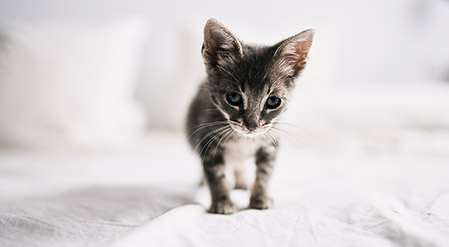
Once weaned, puppies and kittens need to eat three times daily until they are approximately 5-7 weeks old. Puppies and kittens should start with wet food and then progress to dry food only from 7 weeks of age.
At around 5-6 months of age, puppies and kittens should only be fed twice a day. By 12 months of age, reduce the number of meals to one a day.
Life-stage: Adults
Most adult cats and dogs only need one meal per day. However, some medium to large dog breeds, such as working dogs, need to be fed twice daily to accommodate their active lifestyle and have the amount of food provided at each meal adjusted to keep them at an appropriate weight.
Life-stage: Seniors
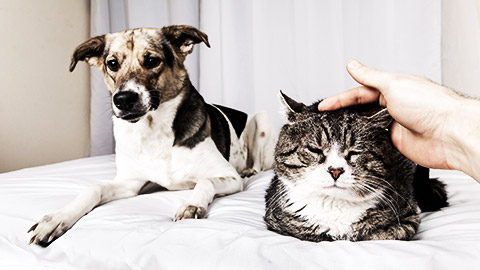
Different breeds have different risks for certain conditions or diseases as the animal ages. For example, certain breeds of dogs appear to be predisposed to obesity. The daily energy requirement (DER) may vary considerably between breeds in the senior stage of life, making it even more important to consider the specific needs of the individual animal when designing feeding plans.
The three most important changes required for a senior’s diet are as follows.
- Reduce the amount of fat in the diet to prevent obesity because the animal’s activity tends to reduce with age.
- Increase the fibre content to assist with gut mobility.
- Reduce the amount of phosphorus to maintain and protect kidney health.
Life-stage: Pregnant and nursing
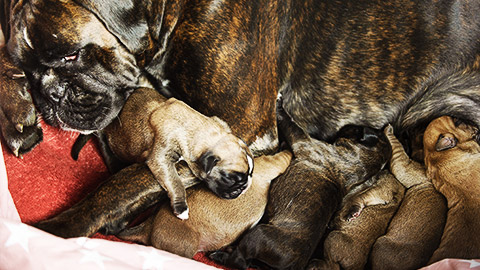
During pregnancy and lactation in cats and dogs, the mother (queen or bitch, respectively) has a much higher calory and calcium need than usual. If she is not provided with the appropriate amount or type of food in this stage, she may not be able to produce enough high-quality milk for the babies.
It is recommended that pregnant and lactating cats and dogs are fed high-quality kitten or puppy food, respectively, because it contains the appropriate nutrient balance for this stage of life as well.
The Role of Supplements in a Balanced Diet
For most healthy animals, feeding should be done once to three times daily, depending on age, breed, species, and lifestyle. Providing them with high-quality commercial food will likely meet all their nutritional needs. High-quality foods will list the protein source as the first ingredient. They will also specify the source of the protein, such as salmon or chicken, rather than a more generic ‘fish’ or ‘poultry’.
Supplements are food products that can be given in addition to a normal diet. There are three roles of food supplements in an animal’s diet. To:
- add necessary nutrition that the animal may be missing or not gaining enough from their normal diet
- provide additional nutrition required by a medical condition
- make the food more appetising.
Supplements are most commonly added to a diet if specific nutritional requirements are not met by the diet alone or if there is a nutritional problem that has been medically diagnosed. For example, adding glucosamine, green lip mussels, fish oil, or chondroitin are common food supplements for dogs with arthritis or joint disease.
If an animal in your care requires food supplements, it will be included in their feeding plan along with the amounts required, how often you need to provide them and how to present them to the animal.
Vitamins and minerals are common food supplements if they are not adequately provided in the main food for specific dietary requirements. However, too much of a vitamin or mineral can be very harmful. For example, excess vitamin C can cause diarrhoea in some animals, and excess calcium can cause a range of health problems in dogs.
Supplements should be used in conjunction with Veterinary advice. It is very important that you identify the correct food and food supplements and prepare them in line with your feeding plans.
Knowledge Check 2
Complete the following four (4) tasks. Click the arrows to navigate between the tasks.
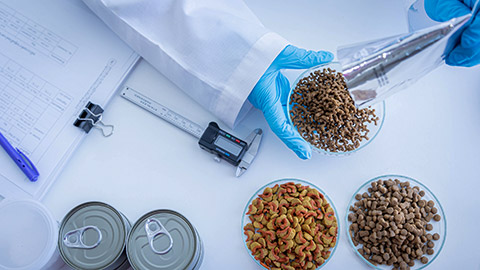
As with preparing food for people, several potential hazards are involved in preparing food for animals. These hazards can be grouped into the following two main areas:
- Storing foods
- Preparing foods.
Hazards in Storing Food Appropriately
The main hazards related to storing food is food contamination and food poisoning. As an animal care worker, it is your responsibility to make sure the food you feed to animals is fresh and hasn’t spoiled. Stale food may be unpleasant to eat, and food that has gone off may cause animals to become sick. So, it is important to consider the following three aspects of storing food correctly:
- Store food in the right conditions
- Store food in appropriate containers
- Use or dispose of food as indicated by the use by and best-before dates.
Storing food in appropriate conditions and containers
Open bags, packets and cans of food should be sealed with an airtight lid or placed in an airtight container. Airtight containers prevent food from becoming contaminated by bacteria, fungi and other pathogens that can cause food poisoning.
Wet and cut fresh foods should be stored in a refrigerator or freezer. The low temperature inside a refrigerator or freezer significantly slows down the growth of any bacteria that may be present in the food and further reduces the risk of food poisoning.
Use by and best-before dates
By law, in Australia, all food with a shelf life of less than two years, including packaged pet food, must be labelled with either a best-before or a use-by date.
The best-before date indicates when the quality of the food may start to decrease, for example, go stale. It is still safe for animals to eat the food after this date, but it may not be as appealing as if it were before the best-before date.
The use-by date indicates when the manufacturers can no longer guarantee that the food has not spoiled or become contaminated. Animals that eat food after the use-by date are at risk of food poisoning. You should throw away food once it reaches its use-by date.
Read Date marking & storage advice, which describes the differences between best before and use by dates in a little more detail.
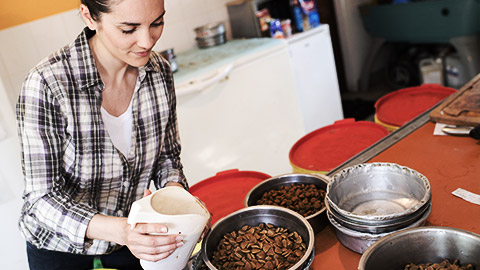
Hazards in Preparing Animal Food
Common hazards to humans during the preparation of animal foods include:
- Manual handling of heavy, large or awkward containers of food, as well as food preparation, storage and distribution equipment
- Sharps injuries (cuts and stabbing)
- Burns or scalding when preparing and handling hot foods
- Possibility of zoonotic infection.
Follow the work, health and safety (WHS) guidelines of your workplace to minimise these types of hazards. Report any concerns you have to your supervisor.
Cross-contamination of food
When dealing with food, you must work in a clean and hygienic environment, as the risk of cross-contamination to animals and humans is extremely high.
Cross-contamination occurs when you transfer the bacteria from raw food (for example, chicken), unclean utensils, dirty hands and preparation surfaces (cutting boards and bench tops), onto foods that have been prepared and are ready to eat.
Contaminated food may cause the animal that eats it or the human that handles it to become sick.
Hygienic food preparation area
Cross-contamination can be easily avoided by following some common procedures. Be sure to follow the procedures of your workplace for food preparation. The procedures are likely to include the following steps:
- Wash your hands thoroughly with soap before and after handling animal foods
- Wear gloves and other PPE, such as an apron
- Use separate utensils, cutting boards and other preparation equipment for each type of food you are preparing (for example, use a different knife and cutting board when cutting up fruit than when you cut up meat)
- Wipe down all surfaces before preparing food.
Reporting Hazards
You must verbally report any hazards or incidents you have encountered to your workplace supervisor. You should also fill out the appropriate WHS form and hand it to your WHS officer within a certain time frame.
Your supervisor should take appropriate measures to ensure that this hazard is dealt with and resolved efficiently and correctly.
Personal Protective Equipment for Preparing Food
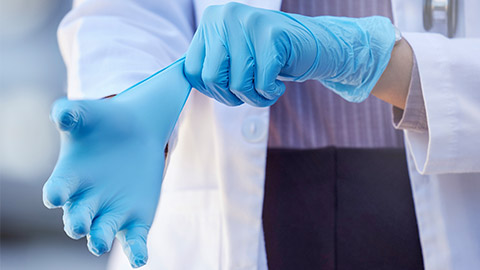
Personal Protective Equipment (PPE) is one of the levels of the hierarchy of control in controlling the spread of infection. Using the PPE will help minimise the exposure of animal care staff to pathogens by decreasing the contamination of clothing and skin. It also reduces the risk of people transferring pathogens between staff and the animals.
Examples of some of the PPE equipment and clothing used in animal care facilities include:
- Aprons, scrub tops or overcoats - Their use means that street clothes cannot be contaminated.
- Gloves - Gloves, whether they are powdered or non-powdered, will reduce the risk of contamination.
- Masks and glasses - Masks and glasses protect your respiratory tract and your eyes.
When preparing food for animals, the key PPE are gloves and potentially an apron, scrub top or overcoat, depending on the type of food you are preparing. If you are working with food that may contain dust or mould and fungal spores, such as damp hay, you may also need to wear a mask and glasses.
Case Study
You are working at a horse care facility, and your task for the day is to clean the horse stables. While cleaning, it's essential to prioritise both your safety and the horse’s safety. "Blaze," a large, spirited horse, ensures his area is clean, comfortable, and safe.
Safety Considerations
Awareness:
- Concern: Horses can be unpredictable, especially if startled. They may kick, bite, or suddenly move when feeling threatened or uncomfortable.
- Precaution: Always approach the horse from the side where they can see you and speak in a calm voice. Ensure that Blaze is tied securely but comfortably outside the stable or moved to a separate paddock while cleaning. Never clean a stable with the horse inside unless necessary.
Personal Protective Equipment (PPE):
- Concern: Stables are often dusty, and there is a risk of exposure to harmful bacteria from manure, hay, and bedding.
- Precaution: Wear gloves, boots with reinforced toes, and a mask if needed. Boots should have non-slip soles to prevent accidents on wet or uneven ground.
Proper Use of Tools:
- Concern: Tools like pitchforks, rakes, and wheelbarrows can be hazardous if used improperly or if left lying around, creating trip hazards.
- Precaution: Ensure all tools are in good condition and handle them carefully. Keep tools organized and out of the way when not in use. Never leave a pitchfork with the tines facing upward.
Dust and Ammonia Exposure:
- Concern: Dust from bedding and manure, as well as ammonia from urine, can cause respiratory issues over time.
- Precaution: Proper ventilation is essential. Open stable doors and windows while cleaning to ensure fresh air circulation. Avoid stirring up excessive dust when removing bedding or sweeping.
Waste Disposal:
- Concern: Manure and wet bedding can create slippery conditions if not handled properly, increasing the risk of falls.
- Precaution: Clean up all waste promptly and dispose of it in the designated area. Always shovel or rake away wet bedding thoroughly to prevent mould growth and odours.
Stable Flooring:
- Concern: The stable floor can become slippery, especially when wet with urine or water, leading to slip-and-fall accidents.
- Precaution: Ensure the floor is dry after cleaning. Use absorbent materials like sawdust or straw to cover wet spots and maintain a dry, stable surface.
After taking all safety precautions, you successfully clean Blaze's stable, ensuring it is free of waste, dust, and hazards. Both Blaze and the stable environment are now clean and safe, minimising health risks and accidents.
Knowledge Check 3
Suitable food and water containers

As part of preparing food for animals, you will need to select appropriate food and water containers for the animal. Where possible, choose:
- Non-slip containers to reduce the chance of spills
- Non-chewable containers to prevent:
- food and bacteria becoming trapped in the bite holes
- the animal from swallowing pieces of the container, resulting in potentially life-threatening internal blockages.
As the person preparing the food and water, you must first check all containers for any damage (cracks or holes) and contamination (not clean or dry) before food preparation. Correctly dispose of any damaged containers and locate suitable replacements.
Wash and dry contaminated containers before use or disposing of them, depending on the type of contamination. For example, a dirty bowl might be contaminated with old food and bacteria that could make the next animal sick. It is safe to wash and dry this bowl before reusing it. However, containers contaminated with potentially toxic chemicals need to be disposed of.
Food Preparation Techniques
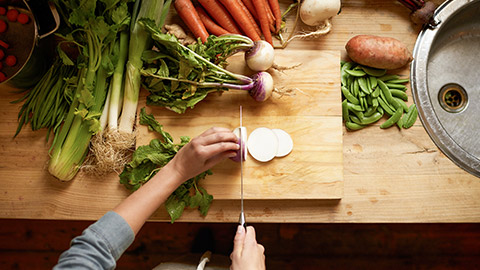
Once you have ensured the food preparation area, utensils and other preparation equipment are clean, and you are wearing the appropriate PPE, it is time to prepare the food for the animal.
Principles of Food Preparation
Raw meat and poultry can contain harmful bacteria, including Salmonella, Listeria, Campylobacter and E. coli that can cause food poisoning.NSW Government Food Authority n.d.
The principles of food preparation minimise the risk of cross-contamination and food poisoning. There are four principles of food preparation:
- Clean
- Separate
- Cook
- Chill
Clean

The first food preparation principle focuses on hygiene.
- Wash your hands well with soap before you start preparing food.
- If you are preparing multiple types of food, it is recommended that you wash your hands with soap frequently throughout the process.
- Wash your hands well with soap after you finish preparing food.
- After you finish, wash all utensils, cutting boards and surfaces with hot soapy water.
Separate
The second principle focuses on preventing cross-contamination.
- Store the different food groups in separate places or in different containers. For example, raw meats should be stored in a different refrigerator than fresh fruits and vegetables, or at least in a different container if they are in the same refrigerator.
- When preparing different food groups, use different utensils and cutting boards.
Cook
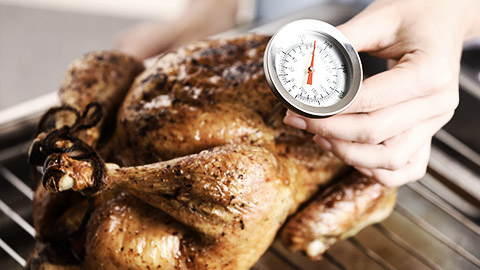
The third principle focuses on preventing food poisoning through heating. If you need to cook food before giving it to the animals, make sure to heat the food to the appropriate temperature. You may need to use a cooking thermometer to check.
The following table states the temperatures at which different types of meats should be cooked to destroy harmful microorganisms (NSW Government Food Authority, n.d.).
| Meat types | Safe temperature |
|---|---|
| Fish | 63°C |
| Minced meat | 71°C |
|
Beef, veal, lamb, pork:
|
|
| Chicken and turkey | 74°C |
| Leftovers | 75°C |
Chill
The final principle focuses on preventing food poisoning through chilling.
Store open wet food, raw meats and cut fruits and vegetables in the fridge or freezer at 4°C or below.
While most dry foods and uncut fruit and vegetables can be stored at 'room temperature', remember that the ambient temperature of a room will depend on the general climate of the area and will change throughout the day and between seasons. If the temperature of the storage area is not consistent, air conditioning, temperature control or an alternative storage place may be required.
The following ranges are the generally accepted temperatures for the different storage locations:
- Freezer: -15°C or less
- Refrigerator: 2°C - 8°C
- Cool: 8°C - 15°C
- Room temperature: 15°C - 25°C (ECA Foundation 2017).
Measuring the Weight and Volume of Food
In most situations, it is likely that you will only need to measure the amount of food to be provided to the animal based on its feeding plan.
Scenario: Felix
Felix is a 3-year-old Pomeranian who has just been dropped off at the boarding facility where you work. Your supervisor has asked you to weigh Felix and determine the appropriate amount of food he should be given each day. Felix is quite active and used to eating twice a day.
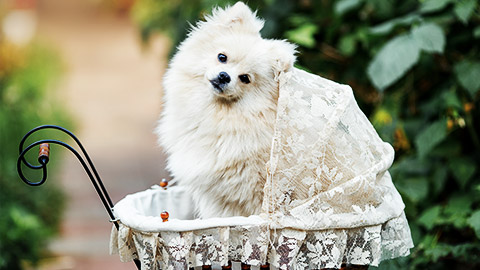
- You weigh Felix and determine that he weighs 2.9 kg.
- Based on his weight and life stage, he will be fed Advance™ Adult Small Breed Turkey with Rice dry food for dogs. The following table shows the feeding guide for this type of food.
Inactive Dog Active Dog Weight of dog Cups/day Cups/day 2.5 kg 1/2 1/2 5 kg 2/3 3/4 7.5 kg 1 1 1/4 10 kg 1 1 1/3 12.5 kg 1 1/2 1 2/3 15 kg 1 2/3 1 3/4 1 cup (250 mL) = 115 grams - Using the previous feeding guide, you identify that you should feed Felix half a cup of dry food every day. This means Felix should receive 1/4 cup in the morning and 1/4 cup in the evening.
$$\begin{aligned}\frac{\mathsf{Total\;amount}}{\mathsf{Number\;of\;meals}}&=\mathsf{Amount\;per\;meal} \\\\\frac{\frac{1}{2}\;\mathsf{cup}}{2}&=\frac{1}{4}\;\mathsf{cup\;per\;meal}\end{aligned}$$
Most dry foods come with a measuring cup. However, the feeding guide typically indicates the volume and weight of a standard measure of the food as well. In the previous scenario, 1 cup of food equals 250 mL and 115 grams.
If the measuring cup is lost or damaged, you can measure each meal in grams or kilograms as appropriate. For example, Felix requires 1/4 cup or 28.75 grams of dry food per meal.
$$\begin{aligned}\frac{1}{4}\times115&=\frac{115}{4}\\\\&=28.75\mathsf{grams}\end{aligned}$$
Knowledge Check 4
Complete the following five (5) tasks. Click the arrows to navigate between the tasks.
